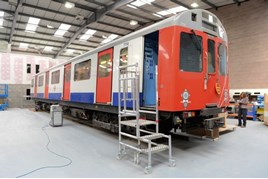- Read part one from RAIL 771: Viva Vivarail's D-Train transformation
"Design is about common sense. It’s a journey between two points, and you want to make sure you get there as efficiently as you can.”
So says Neil Bates, director of Creactive Design. It’s a comment that fits rather neatly into whether you’re talking about design or the railway - or in this case, both.
Creactive, based in Leamington Spa, has worked on a host of railway projects over the years, including the modernisation of DB Regio Tyne & Wear’s Metro interiors, new designs for the interiors of Irish Rail’s Class 22000 fleet, and the Class 168 refurbishment for Chiltern Railways.
The latter was a project carried out when Adrian Shooter was Chiltern’s chairman. In his new guise as chairman of Vivarail, Shooter is again working with Bates (who is also a director for Vivarail), this time on the radical London Underground D78-Stock diesel conversions - the D-train.
In RAIL 771, Shooter told RAIL how the project could ease the shortage of diesel multiple units (DMUs) in the UK. But plugging that gap is merely the reason the idea came about in the first place - now Vivarail is all about providing a “new train”, with passenger experience at the heart of the design.
And Bates is confident that the D-train will do just that: “If we do our jobs properly from the customer-facing perspective, they will like them because they won’t see any difference between those and the new trains.”
That’s going to come down to Vivarail creating the right train environment for the passenger. Bates and his team have a lot of experience understanding passenger requirements and priorities, and in designing the D-train interiors, he says that it is very much about “early buy-in from the TOCs and their customers, to define what they want”.
So Vivarail is not providing an ‘off-the-shelf’, ready-made product?
“We have about 12 or 15 variants of the D-train, broken down into three main ones.”
CommuterRail, CountryRail and CityRail versions allow the design to be tailored to the type of route on which the train is to be used. Routes with frequent stops and high passenger numbers will need different interior layouts to those where passengers tend to make longer journeys and therefore want more space and comfort.
Creactive is exploring a range of options for seating and layouts in the train, to allow TOCs to choose specifically how they want to cater for their passengers.
Says Bates: “In the middle of the train, where we’re blocking doors off, we’re putting seat bays in. With the little nooks and crannies that we have left - instead of building luggage racks (because these trains don’t have them), we’re putting spaces in that would be suitable for a folding bicycle or a baby stroller. Importantly, it doesn’t obstruct the vestibule.”
This doesn’t necessarily mean that every D-train would have this type of space built in, but it is an example of the innovative solutions being worked on to provide ‘building blocks’ from which TOCs can pick. And they are at an advanced stage in development…
“They’re all ready to go. We’ve done the preliminary modelling. We haven’t put them on the train yet because we wanted to talk to the TOCs. They’re now looking at the building blocks. There are one or two more blocks we have left to visualise before we put them on the vehicle, but at that point the interior starts to come together.”
Bates explains the importance of not designing just for the sake of design - practicality is a vital component of the decision-making.
“We’re not using anything that is not fit-for-purpose. Everything that goes into that train has to be fit-for-purpose, in as much as fire, smoke and crashworthiness is concerned. And that is why the supply chain is so important to us, because everything we use must be approved for use on the railway.”
But even though it’s a necessity, complying with regulations is not the first priority for the designs:
“It’s easy, providing you put the customer to the head of the queue. If you start worrying about fire and smoke first, you’ll end up doing certain things. Put the customer first, identify their wants and needs, and put everything after it. They don’t need to know that it doesn’t burn and it doesn’t kill you - that’s my job, that’s hidden.”
The space available on the trains comes down to the type of interior layout chosen and the formation of the seating. Again, this is something for which Creactive is working on several versions.
Says Bates: “The first example is a good comfortable metro and inter-urban seat. All of the aisle-side seats can become priority seats . We’ve patented that. It saves a lot of effort and time, and makes it easier to get in and out of the seat. It creates passing places, too. You can wheel baggage into the space.”
The cheaper version of the interiors that Creactive has mocked up still includes table spaces, however. Why is that so important?













Comment as guest
Comments
No comments have been made yet.